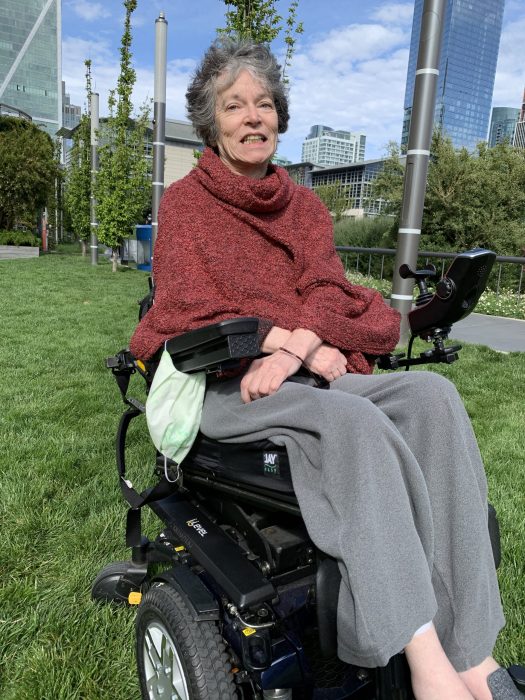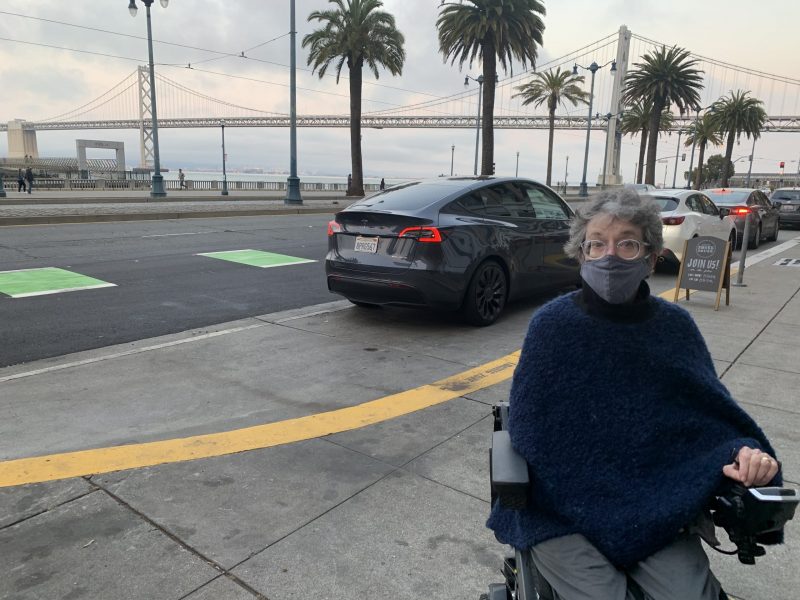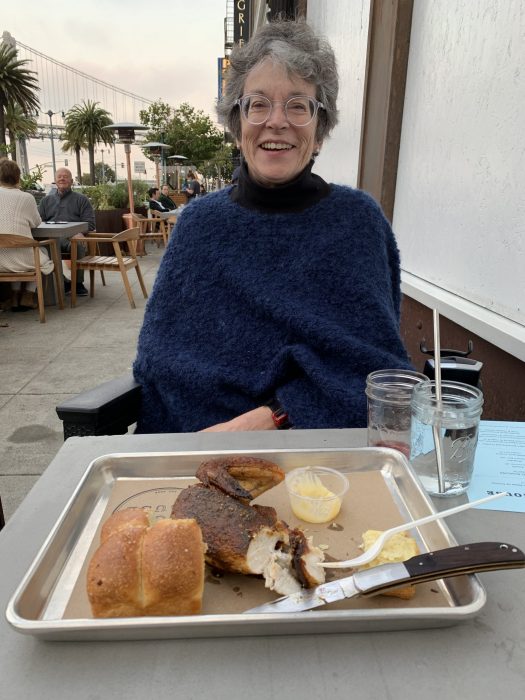Problem getting those pants on, or arms in sleeves? Adaptive clothing devotee says there’s a solution for every complication
Catherine Bauman began experiencing symptoms four or five years before she received the official diagnosis: multiple sclerosis. First, there were numb spots. Maintaining her balance became a challenge. Then, 10 years ago, the former San Francisco city planner began using a wheelchair – first, a manual (“too much pushing”), then later, an electric.
As her illness progressed, that wasn’t the only change Bauman made.
Like many wheelchair users, she discovered it wasn’t easy to find clothing that accommodated her mobility challenges — and her sense of style.
It’s called adaptive clothing, and it was once very hard to find.
“We can’t go to Macy’s and try on things you like,” she said. “It’s not fun to go out to a store and go through racks and racks and racks.”

Bauman and her husband took heart when, in leafing through “New Mobility” magazine one day, they spotted an ad for IZ Adaptive, an online store selling just what she needed. They hadn’t been expecting to find black leather legwarmers, silver bomber jackets or cargo pants, much less natty business suits. But find them they did.
Launched by Toronto designer Izzy Camilleri, IZ Adaptive designs clothing for people with any number of disabilities. Some use wheelchairs, some use walkers; one of her models uses a prosthesis.
Clothes range from a petite to a 3X, with prices ranging from $30 to $700. Offerings include blazers with side zips and magnetic closures, wrap-waist stretch jeans, tear-away athletic pants, leggings cut higher in the back and lower in the front, with pull-tabs on an elastic waistband.
“Our pants are cut to follow the line of a sitting person,” Camilleri said. “What happens is, your organs settle. It becomes very uncomfortable. People end up buying bigger and bigger things. Your feet swell from sitting all day.”
Fashion: it’s about ‘inclusion and sense of self’
Camilleri, a high-end designer celebrated for the flamboyant fur dress coat worn by Meryl Streep in The Devil Wore Prada and flashy costumes used in David Bowie’s Dead Man Walking music video, also teamed up with Starlight Canada to redesign hospital gowns for sick teenagers. She was the first designer in the White Cashmere Collection to feature a model in a wheelchair.
Responding to an appeal by a client, Camilleri first made a cape, then moved to pants.
“A lot of adaptive clothes are made for older people,” she said. “But for those with spinal cord injuries, 84 percent are people between the ages of 18 and 34 and sustained injuries in car accidents or playing sports. If you’re 25, you don’t want to be dressing like your grandmother. In fact, your grandmother, if she uses a wheelchair, probably doesn’t either. You still want to participate in life. It’s all about inclusion and sense of self.”
Urbane and upbeat, Bauman and her husband, retired building inspector Laurence Kornfield, mean to enjoy life. They enjoy their home in the Millenium Tower, which they painted their favorite Harrisburg Green – the same rich hue they’ve painted their previous homes.
And they made the necessary adaptations. Kornfield’s mom changed the doorknobs. They installed grab bars by the front doors, levers on faucets, non-slip flooring.


She’s been able to do many of the things she used to do. “There’s a lady who helps get me up in the morning,” Bauman said. “I have Zoom things. I have a Pilates session.”
“Tell her you go sailing,” Kornfield calls from the kitchen, where he’s mixing her a drink with gin and fresh-squeezed lemon juice, the day a reporter visits. It’s true; she belongs to the Bay Area Association of Disabled Sailors. “They hoist you in,” she said. “It really does feel safe.”
But getting herself dressed was not so easy.
Cutting up boots for slippers
“Adapt” was and remains the watchword for wheelchair users and others with mobility issues – before and after IZ and those the company inspired. “We had these boots we got from Etsy,” Kornfield said, presenting a pair of textured white slip-ons. “We cut them down to slippers. Everything had to be modified.”
Another example: bolts on prosthetic limbs can cause friction. IZ Adaptive makes pants roomy enough to accommodate prosthetics, but clients may opt to apply a patch over a potential trouble spot or visit a local tailor.
Getting her arms into a sweater was tricky, Bauman said. “You have to lean to one side.” Camilleri’s cape-like sweaters changed all that. “I really like the neckline on this,” she said, pointing to a photo of a red sweater without fitted sleeves. A full-length winter cape – blue with a zip-on hood – is another of her favorites.
Camilleri’s success has spurred Tommy Hilfiger, Nike, Target, and Under Armour to develop their own lines. Target has now opened a line of kids’ adaptive duds. “Now that these bigger brands are doing it, it kind of validates the category and opens it up,” she said.
Target customers can order from online catalogues and receive their purchases by mail or pick up at a central location. Macy’s offers curbside or in-store pickup for its Tommy Hilfiger attire.
Camilleri has been designing clothes since 1984. She launched her adaptive line in 2005, then stunned customers by closing up shop in 2016.
‘Options you never knew you had’
“It wasn’t about money,” she said. “We needed to take a few steps back. Growth was very slow.” She realized she would have to give up producing locally if she wanted to keep pricing affordable. Moving the operation to China enabled her to wholesale.
During her 2-year hiatus, social media had become the primary platform for outreach and sales. Facebook alone opens the door to a diversity of potential clients.
“A lot of our customers didn’t even know there was such a thing as adaptive clothing,” Camilleri told Fashion Magazine. “The more brands that come into it, the more people become educated about this type of clothing, that it’s out there for you, to make your life easier and to give you options you never knew you had.”
Understand your problem, and then you will be able to find a way to solve that problem, said Bauman.
“I think people need to think about what is difficult for them and look for clothes that make that thing easier. Like, for me, getting on sleeves is hard, so capes are what really solves that problem.”





